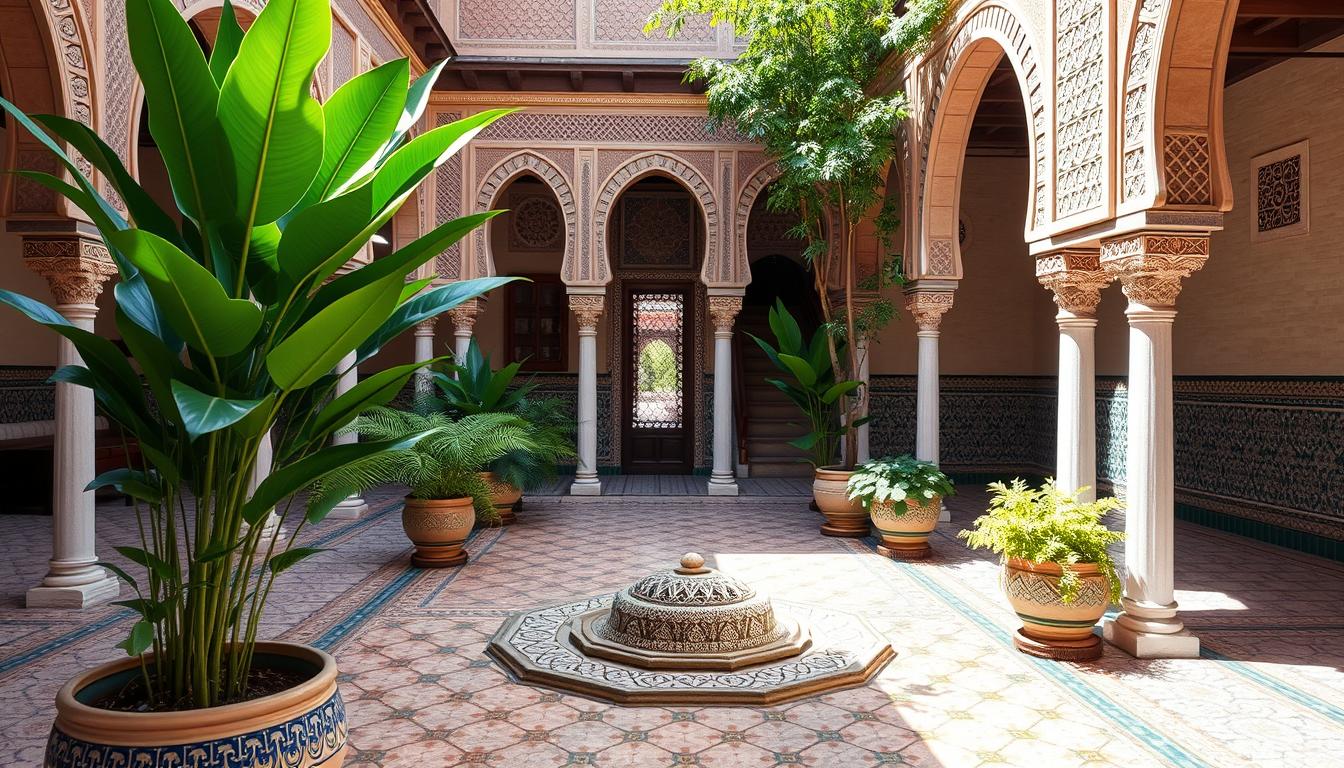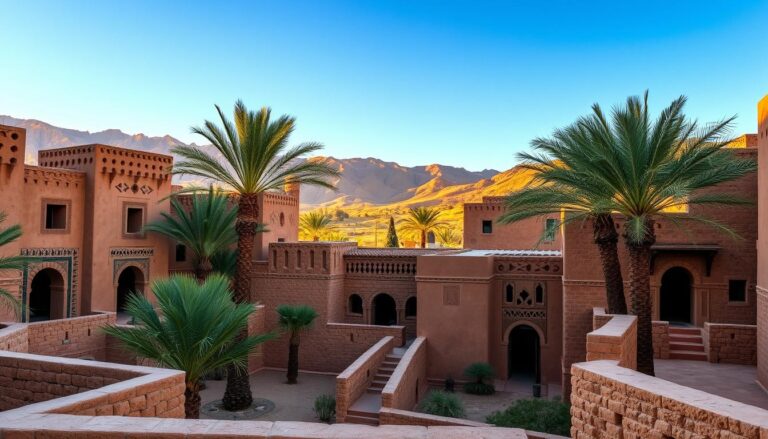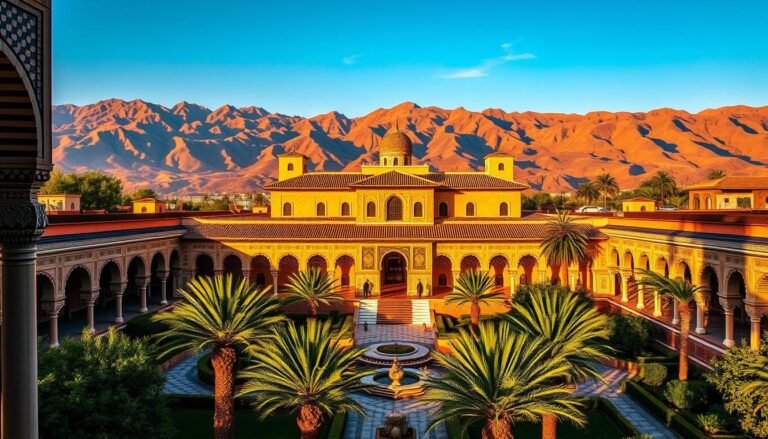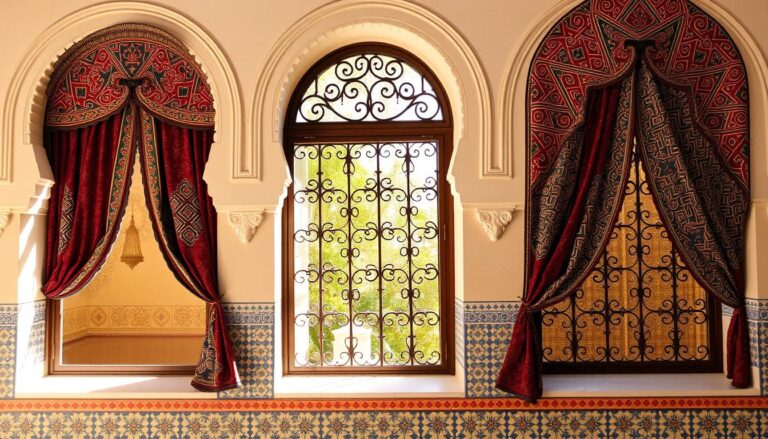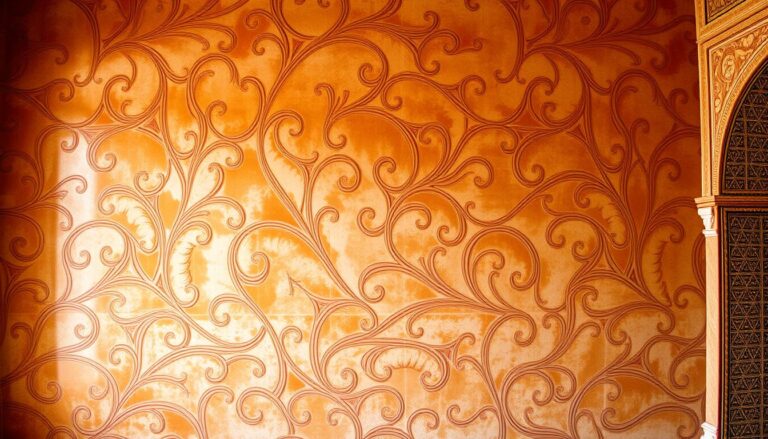Architecture is more than just buildings; it shows a society’s values and dreams. In Morocco, buildings have always shaped communities. They help people feel a sense of belonging and well-being. Traditional Moroccan architecture, with its detailed designs and public spaces, helps us see the importance of buildings.
Looking at Morocco’s architecture, old and new, gives us insights. It shows how buildings can change and reflect society. From the huge Hassan II Mosque in Casablanca to the cozy riads in Marrakesh, Morocco’s buildings show how spaces affect people and culture.
Key Takeaways:
- Moroccan architecture reflects a diverse cultural heritage, blending ancient Roman, Islamic, and local Amazigh influences.
- Traditional Moroccan architecture, such as kasbahs and ksour, emphasize the integration of public spaces and community interaction.
- Modern Moroccan architecture draws inspiration from both traditional and contemporary design, reflecting the country’s evolving cultural identity.
- Architectural spaces in Morocco play a crucial role in shaping social experiences, fostering a sense of community and preserving cultural traditions.
- Sustainable and inclusive design approaches in Moroccan architecture aim to create spaces that enhance human well-being and promote social cohesion.
The Power of Architecture to Shape Society
Architecture is more than just buildings. It shapes how people interact and see their world. It shows a society’s culture and values through its design.
Architecture as a Reflection of Cultural Values
The buildings in a place show its culture. Historic buildings and modern skyscrapers tell a story of a society’s identity. They reflect the beliefs and traditions of the people.
The Impact of Built Environments on Human Well-being
Studies in environmental psychology show how buildings affect our mood and life quality. Good design can make us feel connected and happy. Architects and planners can make spaces that bring people together and improve lives.
“Architecture is not merely a shelter, but a reflection of the culture and values of the society that creates it.”
Moroccan Architecture: A Blend of Cultures and Traditions
Morocco’s architecture is a mix of many cultures and histories. It shows the influence of Berbers, Islam, and Europe. This blend has shaped the country’s buildings over time, making them unique and meaningful.
Historical Influences on Moroccan Architecture
The architecture in Morocco has been shaped by many things. Climate, materials, and the beliefs of rulers have all played a part. The Berbers, who arrived in 110 BCE, used mud bricks in their buildings.
Islam came to Morocco in the 8th century, bringing new designs for mosques and the use of tiles. The Moors from Spain added arches and tiles in the 11th century. These changes made Moroccan buildings special.
France’s rule from 1912 also had an impact. They set rules for building, like limits on height and design. These rules changed how cities were planned and built.
The Significance of Public Spaces in Moroccan Cities
Public spaces in Moroccan cities are lively and important. They are where people meet, share, and celebrate. Souks, plazas, and riads are the heart of these cities.
Riads were once homes of the wealthy. They have courtyards and fountains, showing Islamic and Moroccan styles. Now, they attract visitors from everywhere, showing off Moroccan design and welcome.
“Moroccan architecture is a unique blend of Arab, Berber, and European styles, creating a visual appeal that captivates tourists and locals alike.”
The mix of Berber, Islamic, Moorish, and French styles makes Moroccan architecture special. It’s known for its patterns, arches, fountains, and tiles like Zellij.
Social significance of architectural spaces in Morocco
The architectural spaces in Morocco are very important. They show the country’s rich culture and help people come together. Traditional buildings and public spaces are key in building Moroccan society.
Mosques like the Hassan II Mosque in Casablanca are more than places of worship. They are where communities meet and socialize. Koranic schools, or medersas, are places of learning and cultural preservation.
The traditional Moroccan buildings in old medinas have a unique style. Their narrow alleys and courtyard riads create a sense of community. This style brings people closer to each other and to their surroundings.
The ville nouvelles (new towns) built during the French and Spanish rule are different. They have wider streets and a more European feel. These areas are efficient but lack the cultural spirit of traditional Moroccan spaces.
The designs and decorations in Moroccan buildings show the country’s artistic side. They make people proud of their culture. Traditional crafts like woodwork and tilework add to the beauty and significance of these spaces.
As Moroccan architecture changes, keeping its cultural identity is key. It’s important to create spaces that bring people together. This helps build a strong, united Moroccan society.
“Moroccan architecture is not just a reflection of the country’s history and cultural traditions, but also a powerful tool for shaping the social fabric of its communities.”
The Role of Inclusive Design in Fostering Social Cohesion
In Morocco, architecture is changing, focusing more on inclusive design. This shift aims to improve social cohesion and community engagement. Architects and urban planners are making public spaces more welcoming for everyone.
This effort helps people feel connected and interact more. It also tackles social inequality. By designing spaces that are accessible and diverse, Moroccan cities are becoming more inclusive. They are becoming places where different cultures meet and everyone’s well-being is considered.
Accessible and Inclusive Public Spaces
Public spaces are key in building social cohesion and community. By using inclusive design, these areas become welcoming to all. This includes people of different abilities, backgrounds, and economic statuses.
- Features like ramps, wide paths, and tactile signs make spaces more accessible for those with disabilities.
- Adding cultural elements, such as public art and seating, helps people feel part of the community.
- Choosing sustainable designs also benefits the community’s health and social bonds.
By focusing on inclusive design, Moroccan cities can become centers of social cohesion. Here, everyone feels valued and can join in community activities.
“Architecture has the power to shape not only the physical spaces we inhabit, but also the social fabric of our communities. By embracing inclusive design, we can create public spaces that foster social cohesion and enable all individuals to actively participate in the life of their city.”
Architecture as a Tool for Community Engagement
Architecture is more than just buildings. It can be a powerful tool for community engagement and social impact design. By creating public spaces and buildings that encourage people to come together, architects and urban planners can strengthen community bonds.
Placemaking focuses on making spaces that meet local needs and dreams. It builds a sense of belonging and pride. In Morocco, where architecture is deeply tied to culture, this approach helps include everyone’s voice in development.
“Well-designed sporting facilities, like the Grand Slam tennis tournaments, can serve as icons for cities, attracting visitors and residents and promoting community engagement.”
Public spaces play a big role in bringing people together. In Africa, protests have shown how important these spaces are for social change. Architects can design spaces that spark positive change, from sports facilities to historic sites.
By combining architecture and community engagement, designers can create stronger, more aware communities. As we face big social and environmental issues, the need for social impact design will grow. It’s key to building a better future.
Preserving Cultural Identity through Architecture
Keeping Moroccan architectural heritage alive is more than just saving old buildings. It’s about protecting the country’s culture and traditions. Traditional Moroccan buildings show the people’s creativity and values through their designs and materials.
By saving these architectural wonders, communities keep their heritage alive. This effort helps in sustainable development and community growth. It also lets locals shape their environment’s future.
The Importance of Preserving Architectural Heritage
Zellij, a key part of Moroccan architecture, highlights the cultural value of these buildings. Each Zellij tile is a masterpiece made by skilled Moroccan artisans. These tiles, with their geometric patterns and calligraphy, reflect the country’s spiritual and temporal power.
Zellij’s importance is seen in both old and new Moroccan buildings. Places like the Hassan II Mosque in Casablanca and the Alhambra in Granada showcase its beauty. Efforts to train artisans and restore historical sites aim to keep this heritage alive.
“The meticulous handcrafting techniques involved in creating Zellij ensure each tile is unique and adds to the overall beauty of installations.”
Preserving Morocco’s architecture helps communities keep their cultural identity strong. This approach to urban renewal empowers locals to shape their environment. It ensures their cultural traditions stay alive.
Conclusion: Shaping a More Socially Conscious Future
Looking ahead, the role of architecture in Morocco’s future is key. It will shape the country’s social, cultural, and economic scenes. Architects and planners can make spaces that bring people together and empower communities.
By focusing on inclusive design and cultural preservation, Morocco can build a better future. This future will be fair, sustainable, and full of cultural richness. The built environment will show off Morocco’s diverse traditions and hopes.
Research shows that values and power matter in changing spaces for the better. Architects and planners should listen to local communities. This way, they can create spaces that truly meet people’s needs.
This approach helps keep Morocco’s architectural heritage alive. It also lets people take an active role in their surroundings. This leads to a stronger sense of community and ownership.
In Morocco’s growth, socially conscious architecture is crucial. It ensures development is not just about money but also about people and culture. Architects can help create a future where everyone thrives.
They can make spaces that unite people and give them power. This way, Morocco’s rich culture can shine through. The built environment will be a symbol of unity and diversity.
Source Links
- Moroccan architecture
- An Exploration of Modern Moroccan Architecture – The Yale Globalist
- ISIM-Newsletter-08
- ISVS e-journal, Vol. 1, no.1,
- Urban design and architecture in the service of colonialism in Morocco
- The Rich and Vibrant History of Moroccan Architecture.
- Morrocan Culture: A Vibrant Tapestry of Influences – Eltoro Hotel
- ▷ Art and architecture in Morocco | Chic Morocco
- Riads of Morocco: a Brief History
- People–Place Narratives as Knowledge Typologies for Social Sustainability: Cases from Urban Contexts in the Global South
- Designing Against Hostile Architecture for Inclusive Cities – Parametric Architecture
- Cultural Fusion in Design: Integrating Global Influences into Local Architecture
- Architecture from Morocco | ArchDaily
- Competition: Fes home and retreat, Morocco – The Architectural Review
- Cultural Heritage of Zellij in Moroccan Architecture | Paris Tile
- Cultural Partitions with Tourism | Syracuse University London
- Environmental and socio-cultural transition from traditional courtyard dwellings to contemporary housing practices in Morocco: insights from Arab and East Asian regions – Journal of Umm Al-Qura University for Engineering and Architecture
- Introduction

The Editorial Team is a passionate group of Morocco enthusiasts dedicated to sharing the beauty, culture, and wonders of this captivating country. With diverse backgrounds and a deep love for travel, we strive to bring you engaging and informative content that inspires your Moroccan adventures. From uncovering hidden gems and sharing local insights to exploring mouthwatering cuisine and showcasing the vibrant lifestyle, our team is committed to providing you with valuable resources and exciting stories that enhance your exploration of Morocco. Join us on this journey as we celebrate the rich heritage and unforgettable experiences that make Morocco truly special.

